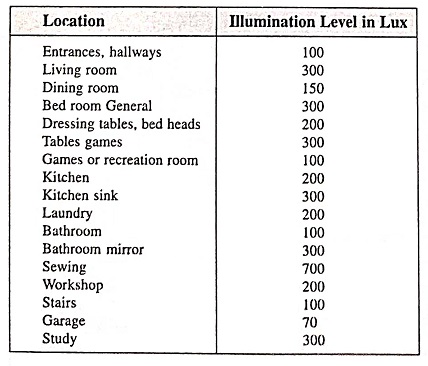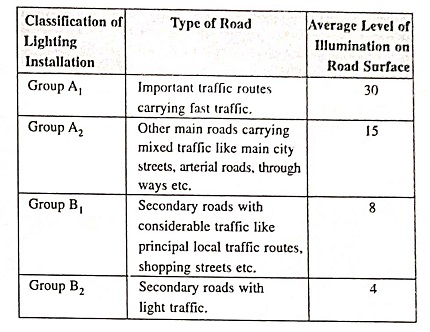Design of Lighting Schemes:
The Design of lighting schemes should be such that it may,
- provide adequate illumination,
- provide light distribution all over the working plane as uniform as possible.
- provide light of suitable colour, and
- avoid glare and hard shadows as far as possible.
The following factors are required to be considered while design of lighting schemes.
1. Illumination Level: This is the most vital factor because a sufficient illumination is the basic means where by we are able to see our surroundings, unless they are themselves light sources, since only when illuminated do the objects take on the necessary brightness. It is the task of illumination to give objects a distributed brightness. Body colours have property of reflecting light in different degrees. It is this differential brightness which gives essential perception of details. For each type of work there is a range of brightness most favourable to output, i.e., which causes minimum fatigue and gives maximum output in terms of quality and quantity. Degree of illumination, to give necessary brightness to the objects depends upon (i) the size of the object to be seen and its distance from the observer—greater the distance of the object from observer and smaller the size of the object, greater will be the illumination required for its proper perception and (ii) contrast between the object and back ground—greater the contrast between the colour of the object and its back ground, greater will be the illumination required to distinguish the object properly. Objects which are seen for longer duration of time require more illumination than those for casual work. Similarly moving objects require more illumination than those for stationary object.
Illumination level required, as per ISI, in various parts of a building is given below:
Illumination level required, as per ISI, for various types of traffic routes is given below:
2. Uniformity of Illumination: The human eye adjusts itself automatically to the brightness within the field of vision. If there is a lack of uniformity, pupil or iris of the eye has to adjust more frequently and thus fatigue is caused to the eye and productivity is reduced. It has been found that visual performance is best if the range of brightness within the field of vision is not greater than 3 : 1, which can be achieved by employing general lighting in addition to localised lighting. Apart from the consideration of causing fatigue, local lighting without using matching general lighting creates psychological feeling of loneliness, gloom and unfriendliness. The modern trend is thus towards ‘localised lighting plus general lighting’ and towards the adoption of “general lighting oriented towards the working surface” especially in mass production factories, offices, drawing offices, shops etc.
3. Colour of Light: The appearance of the body colour entirely depends upon the colour of the incident light. In general the composition of the light should be such that the colour appears natural, e., its appearance by artificial light is not appreciably different from that by daylight. Daylight fluorescent tubes nowadays make it possible to illuminate economically even large spaces with artificial daylight giving good colour rendering and at sufficiently high level. For certain applications such as street lighting, colour of light does not matter much if different components have not to be distinguished from each other by their colours, highly efficient discharge lamps, which cause colour distortion, can be used.
4. Shadows: In lighting installations, formation of long and hard shadows causes fatigue to eyes and, therefore, is considered to be a shortcoming. Complete absence of shadows altogether again does not necessarily mean an ideal condition of lighting installations. Contrary, perhaps to popular opinion, a certain amount of shadow is desirable in artificial lighting as it helps to give shape to the solid objects and makes them easily recognised. Objects illuminated by shadowless light appear flat and uninteresting, contours are lost, and it is difficult for the eye to form a correct judgement of the shape of an object. However, there is one exception to this, i.e., in drawing offices, where we are to see flat surfaces, shadowless light is essential otherwise shadows will hinder the work. Hard and long shadows can be avoided by (i) using large number of small luminaries mounted at a height not less than 2.5 metres and (ii) by using wide surface sources of light using globes over filament lamps or by using indirect lighting system.
5. Glare: It may be direct or reflected, i.e., it may come directly from the light source or it may be reflected brightness such as from a desk top, nickelled machine parts, or calendered paper.
Direct glare from a source of light is the more common, and is more often a hindrance to vision. A glance at the Sun proves that an extremely bright light source causes acute eye discomfort. Light sources of far less brilliancy than the Sun, such as the filament of an incandescent lamp, or the incandescent mantle of a gas lamp, also cause discomfort by a direct glare. Reflected glare is a glare which comes to the eyes as glint or reflection of the light source in some polished surface.
Toleration of bright light sources in the intermediate vicinity is made possible by locating them at such a height as to place them above the ordinary range of vision.
Metal reflectors for industrial lighting are ordinarily provided with a skirt around the rim of the reflector.
6. Mounting Height: The mounting height will largely be governed by the type of the building and type of lighting scheme employed. In the case of direct lighting, in rooms of large floor area, the luminaries should be mounted as close to the ceiling as possible. Lowering them not only will make the illumination less uniform, but will also bring them more into the field of vision, thus increasing the glare, without causing an appreciable increase in the coefficient of utilization. In the unusual case of small rooms with high ceilings, there is something to be gained by lowering the luminaries, but even here a better solution might be to use filament lamps with focusing reflectors and to mount them high.
In the case of indirect and semi-indirect lighting, it would of course be desirable to suspend the luminaries far enough down from the ceiling in order to give reasonably uniform illumination on the ceiling. In practice this is usually taken to mean that the length of the suspension tubes should be one-quarter to one-third the horizontal spacing between the rows of luminaries. Unfortunately it is often impossible to suspend them as far down as this, because it is quite generally recognized that there should be a minimum clearance of 2.5 metres between the luminaries and the floor. It follows that in rooms having low ceilings, the illumination on the ceiling is unavoidably non-uniform. This is not objectionable, because the ceiling is not a working plane.
7. Spacing of Luminaries: Correct spacing is of great importance to provide uniform illumination over the whole area and thus do away with comparatively dark areas which are so often found when the fittings are badly spaced.
In the case of direct and semi-direct luminaries the ratio of the horizontal spacing between rows to the height of the luminaries above the working plane depends to quite an extent on the candle power-distribution curve of the luminaire. With fluorescent luminaries it is good practice to aim at a value of unity for this ratio, and to set an upper limit of 3/4. In the case of tungsten lamps combined with focussing reflectors, the ratio of spacing to height should be about 0.6.
In the case of indirect and semi-indirect luminaries, it is good practice to aim at a horizontal spacing between rows approximately equal to a height of the ceiling above the working plane, and in no case should the horizontal spacing exceed 1 1/2 times this height.
In the case of fluorescent luminaries, it is a common practice to join two or more luminaries end to end so that they can share a common outlet. In fact it often works out well to use continuous rows of luminaries, especially when the specified illumination is fairly high.
8. Colour of Surrounding Walls: The illumination in any room depends upon the light reflected from the walls and ceilings. White walls and ceilings reflect more light as compared to coloured ones.

